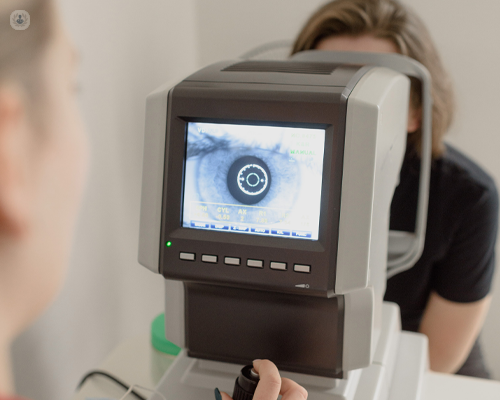Cornea guttata: What is it and when do their presence indicate eye problems?
Written by:Cornea guttata potentially leads to significant vision issues such as a significant reduction in vision.
Here to help us understand the nature of why they come together to form one mass – and more about the condition - is leading consultant ophthalmologist in Worcester, Hereford and Droitwich Mr Geraint Williams.

What are the characteristics and symptoms of cornea guttata?
A gutta in Latin means drop. When we think about the cornea, the clear window of the eye, this means a microscopic bulge in one of the back layers called Descemet’s membrane. This translates in to a change in the very back surface of the cornea called the endothelium. The endothelium is a layer of cells that act as a pump to make sure that the cornea does not become waterlogged. When there are lots of gutta coalesce, we then refer to the cornea as having guttae. These in turn can disrupt the endothelial cells.
These changes can be seen on the microscope the ophthalmologist uses to assess your eye. The take on a ‘beaten metal appearance’ and can be seen as dark spots on examination of the centre of the cornea. If they are seen in the periphery of the cornea, they are called Hassall-Henle bodies.
In the initial stages there are often no symptoms with corneal guttata. With time however they cause a loss of transparency in the cornea which can result in glare and scatter. If the corneal guttata become progressively worse and damage the endothelial cells underneath, then this can cause blurring of the vision and haloes around lights. This is typically worse in the mornings to begin with but can become permanent with time. This can cause severe reduction in vision. These changes can also cause discomfort in the eye, especially if the swelling leads to bullae, small bubbles on the surface which can break down like a blister.
How does cornea guttata impact vision and what potential complications can arise?
The presence of guttae themselves does not mean there is an immediate problem with your cornea. However, they can be present in conditions such as Fuchs’ endothelial dystrophy. This is an inherited condition, meaning it can be passed down from one generation to the next. In some patients nothing more happens, but in others the guttae can become progressively worse, together with damage to the endothelial cells lining the cornea.
In turn this can result in the cornea becoming waterlogged, swollen and this in turn can affect vision. These changes can be accelerated after cataract surgery (clouding of the natural lens of the eye), even when this is uncomplicated, because the energy needed to break up a cataract relies on ultrasound which damage the endothelial cells.
What are the diagnostic techniques used to identify cornea guttata?
We can usually see guttata on examination of the cornea with a microscope. Further tests of the health of the endothelium can be undertaken by a specular microscopy (a specialist microscope) which helps your doctors to count these cells and look for changes which may indicate the cornea is at risk of becoming waterlogged and swollen.
What causes cornea guttata, and are there any known risk factors associated with it?
Guttata are often inherited within families but can appear for no reason. Usually, they are spotted by your optometrist or ophthalmologist on routine testing or of your symptoms make them suspicious you have a problem with your cornea.
In many instances, it doesn’t represent a problem and arrangements for monitoring the condition can be made with your eye care specialist.
What are the available treatment options for cornea guttata?
The ultimate treatment for corneal guttata is a partial thickness corneal transplant called a keratoplasty. The decision to undertake this will be based on a number of factors including the impact on your quality of life, the need for other surgery e.g., cataract surgery and your individual circumstances.
Corneal guttata are usually managed by ophthalmologists and often they need input of surgeons with a specialist interest in corneal transplantation.
If you’re experiencing corneal guttata and require expert attention, visit Mr Williams’ Top Doctors profile to arrange a consultation.


